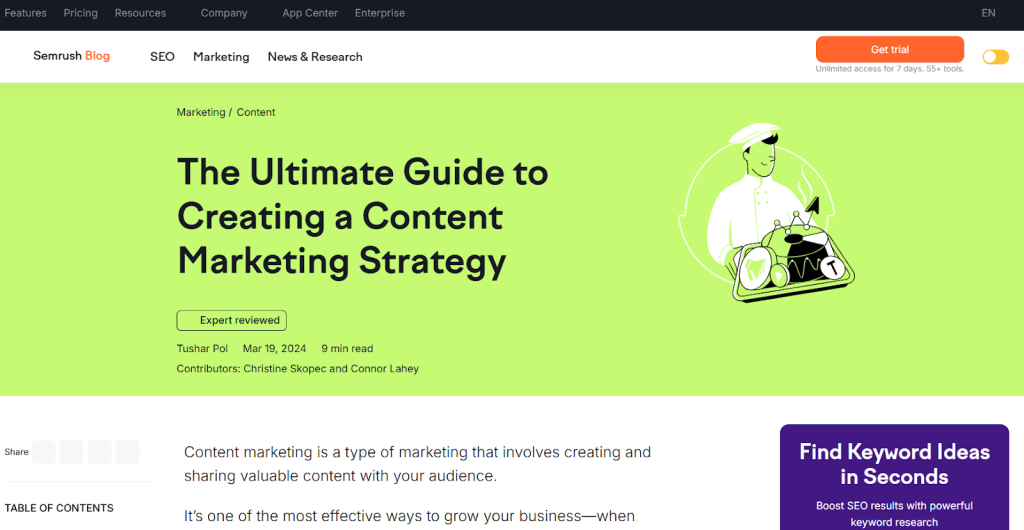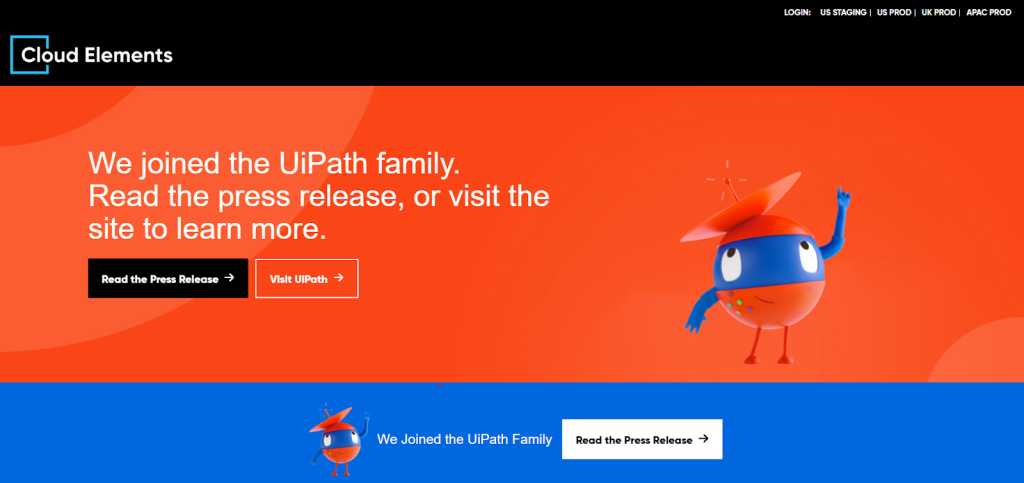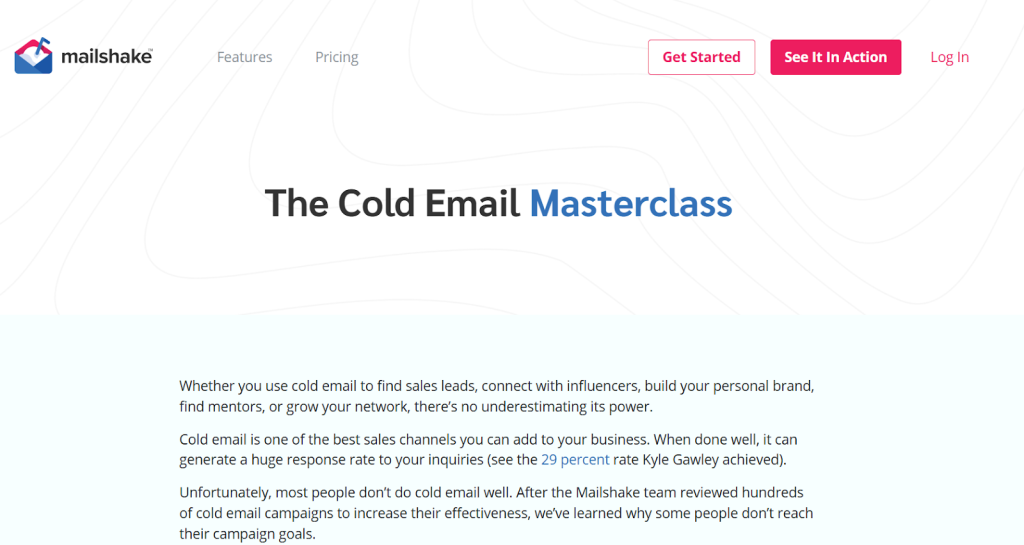Explore the concept of pillar pages and why they’re a crucial part of any effective content strategy. Dive into standout pillar page examples that showcase their design, structure, and impact. Whether you’re building a content hub for your business or rebuilding an existing strategy, these examples will inspire your next move.
Did you know that websites with well-structured content hubs can see up to a 50% increase in organic traffic?
Pillar pages are not just a buzzword, they are a game-changer for improving search rankings, enhancing content visibility, and organizing information in a user-friendly way.
What is a Pillar Page?
A pillar page is a detailed resource that covers a broad topic in depth. It acts as the central hub of a content cluster, linking to related, more specific articles or blog posts. Think of it as the foundation of a well organized content strategy, where users can find essential information in one place while being directed to related subtopics for deeper exploration.
Pillar pages are structured to provide clarity and value. They often include a logical flow of information, subheadings for easier comprehension, and plenty of internal links connecting related pieces of content. This interlinking not only helps readers explore related ideas but also signals search engines about the relationship between the pillar page and its cluster content, improving rankings for targeted keywords.
According to HubSpot, content that uses a pillar cluster model can increase organic traffic by 40% over six months.
These pages matter because they are highly effective for both users and search engines. For users, they provide a one stop resource that covers everything they need to know about a topic, reducing the need to search elsewhere. For search engines, pillar pages demonstrate expertise, authority, and relevance, which are critical factors for achieving higher rankings. A study by Ahrefs found that 96.55% of web pages receive no traffic from Google, often due to poor structure and lack of interlinking issues a well-designed pillar page can address.

By implementing pillar pages into your content strategy, you can improve discoverability, boost keyword performance, and keep visitors engaged longer, ultimately leading to better user experience.
How to Identify a Great Pillar Page?

A great pillar page is more than just a long article; it is a comprehensive, well organized hub of information designed to engage users and satisfy search engine criteria. Here are the key attributes that make a pillar page stand out:
Content Depth and Relevance
A standout pillar page provides in-depth coverage of its topic, addressing the most critical questions and subtopics in a way that resonates with its audience. It balances breadth and depth, ensuring readers find both an overview and detailed insights.
Studies show that long-form content, which is a hallmark of pillar pages, generates 3x more traffic and 4x more shares than shorter articles.
Search Intent Optimization
Effective pillar pages are optimized for both users and search engines. This includes incorporating primary keywords strategically, using subheadings to organize content, and ensuring meta descriptions and title tags are optimized for relevance.
According to BrightEdge, pages with structured content and clear keyword focus perform 2.5 times better in search results than unstructured pages.
Internal Linking
A key feature of a great pillar page is its internal linking structure. Links to related cluster content not only enhance the user experience but also help search engines understand the topic’s context and hierarchy. Websites with strong internal linking see a 40% boost in page views on average
Visual Appeal and Accessibility
High performing pillar pages are visually engaging, using graphics, charts, and other visual aids to break up text and convey information effectively. They’re also designed for easy reading across devices, ensuring content is accessible to all users. A well-designed page can lead to a 73% increase in user engagement.
The Importance of Pillar Page Strategy
Behind every successful pillar page is meticulous planning and research. Identifying the right topic requires understanding your audience’s needs, analyzing search intent, and assessing keyword competition. The layout and content structure should be deliberate, guiding readers through the information logically and cohesively. A research indicates that companies that focus on strategic content creation see 13x higher ROI compared to those without a strategy.
Best Pillar Page Examples
Below are detailed examples of outstanding pillar pages, each showcasing unique qualities that make them effective. These examples span various industries, offering insights into different approaches for structuring and presenting comprehensive content.
1. The Ultimate Guide to Sales Qualification – HubSpot

Focus: Sales and business development
Key Features:
- Covers every aspect of sales qualification, from defining key terms to exploring strategies and frameworks.
- Includes dynamic visuals like infographics and step-by-step illustrations to explain complex concepts.
- Strong internal linking to related resources on sales pipelines, CRM tools, and lead nurturing.
Why It Works:
This guide serves as a reference for sales professionals and teams looking to refine their qualification process. Its focus on actionable advice and clear explanations ensures high engagement. HubSpot reports that their pillar pages contribute significantly to their lead generation efforts, increasing traffic by over 40%.
2. The Complete Guide to Equity Compensation for Startups – Ravio

Focus: Startup equity and employee benefits
Key Features:
- In-depth exploration of equity compensation models, valuation, and legal considerations.
- Clean layout with embedded calculators and downloadable templates for practical application.
- Thoughtfully designed FAQs addressing common queries about equity plans.
Why It Works:
This page provides comprehensive insights into a niche topic, making it invaluable for startups and their employees. Ravio’s use of interactive tools ensures that users not only consume content but also engage with it meaningfully.
3. The Ultimate Guide to Creating a Content Marketing Strategy – Semrush

Focus: Content marketing and digital strategy
Key Features:
- Extensive coverage of content marketing, from planning and execution to measurement and optimization.
- Includes examples, case studies, and real-world data to validate the strategies discussed.
- Multiple call-to-action (CTA) points to related tools and services offered by Semrush.
Why It Works:
By positioning itself as a one-stop resource for content marketers, this pillar page not only educates users but also promotes Semrush’s suite of tools effectively. Pages like this are known to drive 3x more leads than shorter, less comprehensive articles.
4. Beginner’s Guide to Wine – Wine Folly

Focus: Wine education for enthusiasts and beginners
Key Features:
- Simple, approachable language with stunning visuals like wine maps and flavor wheels.
- Organizes content by types of wine, regions, and pairing tips, making it highly accessible.
- Offers links to additional resources, including paid courses and books by Wine Folly.
Why It Works:
This page appeals to both casual readers and serious wine enthusiasts. Its structured approach helps Wine Folly become a go-to resource in the industry, contributing to their status as an authority on wine education.
5. The Definitive Guide to API Integration – Cloud Elements

Focus: Software development and APIs
Key Features:
- Comprehensive breakdown of API integration types, best practices, and use cases.
- Interactive examples and code snippets for developers.
- Uses diagrams and flowcharts to simplify technical concepts.
Why It Works:
By addressing the complexities of API integration, this pillar page helps developers and businesses solve real-world challenges. Cloud Elements reports increased traffic and engagement on their technical resources after implementing this page.
6. Remote Work Guide – Zapier

Focus: Productivity and remote work strategies
Key Features:
- Covers tools, workflows, and tips for building a productive remote work environment.
- Data-driven insights from Zapier’s internal research on remote work trends.
- Incorporates testimonials and case studies from remote-first companies.
Why It Works:
As a remote-first company, Zapier leverages this guide to showcase their expertise. Remote work has grown 91% over the past decade, making this page highly relevant and frequently shared.
7. No-Nonsense Guide to Agile Development – Atlassian

Focus: Agile methodologies and software development
Key Features:
- Explains Agile principles, frameworks like Scrum and Kanban, and implementation tips.
- Links to Atlassian’s tools such as Jira and Confluence, which support Agile teams.
- Includes infographics and workflow templates for practical guidance.
Why It Works:
This page positions Atlassian as a thought leader in Agile development while promoting their tools. Agile adoption has increased by 60% in recent years, making this guide highly relevant for teams.
8. What is Ecommerce? A Beginner’s Guide to Online Business – Semrush

Focus: Ecommerce basics and strategies
Key Features:
- Breaks down the fundamentals of ecommerce, including platform options, marketing strategies, and operational tips.
- Visual aids like charts and comparison tables to simplify decision-making for readers.
- Links to advanced content on ecommerce SEO and PPC strategies.
Why It Works:
This guide targets entrepreneurs and small businesses entering the ecommerce space, driving awareness and adoption of Semrush’s tools for online growth.
9. Brand Awareness Guide – Typeform

Focus: Branding and marketing strategies
Key Features:
- Discusses the role of surveys, quizzes, and forms in building brand awareness.
- Share success stories of companies using Typeform’s solutions effectively.
- Combines data and creative visuals to engage readers.
Why It Works:
This page highlights how Typeform’s services fit into broader branding strategies, attracting marketers seeking creative solutions.
10. Performance Management Guide – Betterworks

Focus: HR and organizational development
Key Features:
- Covers the basics of performance management systems, from goal-setting to feedback mechanisms.
- Includes research-backed insights and best practices for HR professionals.
- Offers downloadable templates for implementing performance management strategies.
Why It Works:
This guide provides actionable advice for improving workplace productivity, aligning with Betterworks’ mission to enhance employee performance.
11. A Step-by-Step Guide to Competitive Market Analysis – Zapier

Focus: Market analysis and business planning
Key Features:
- Walks users through competitive analysis tools, techniques, and case studies.
- Links to Zapier’s automation tools that simplify research processes.
- Provides downloadable worksheets to organize findings effectively.
Why It Works:
This guide appeals to small businesses and startups seeking to refine their competitive edge.
12. Google Analytics for Beginners: Getting Started with GA4 – Semrush

Focus: Digital analytics and data interpretation
Key Features:
- Simplifies GA4’s interface and features with step-by-step instructions.
- Offers tutorials and links to advanced analytics strategies.
- Incorporates screenshots and video tutorials for clarity.
Why It Works:
With GA4 adoption becoming mandatory, this guide is essential for marketers transitioning from Universal Analytics, boosting engagement and tool usage for Semrush.
13. Cold Email Masterclass – Mailshake

Focus: Email marketing and outreach strategies
Key Features:
- Covers cold email best practices, templates, and optimization techniques.
- Includes success stories and data-backed examples of effective campaigns.
- Provides links to Mailshake’s software for automating cold emails.
Why It Works:
This guide is a valuable resource for sales professionals and marketers looking to improve their outreach strategies.
14. Everything You Need to Know About APIs – Zapier

Focus: API fundamentals and business applications
Key Features:
- Explains APIs in simple terms, with examples of real-world use cases.
- Links to tools and resources for API testing and implementation.
- Uses charts and diagrams to visualize complex ideas.
Why It Works:
This guide establishes Zapier as a trusted source for API integration knowledge, enhancing their credibility with developers.
15. The Complete Legislation Guide to EU Pay Transparency Directive – Ravio

Focus: HR compliance and European labor laws
Key Features:
- Breaks down the directive’s implications for employers and employees.
- Provides timelines and actionable advice for compliance.
- Includes downloadable legal templates and checklists.
Why It Works:
This guide addresses a critical, timely issue for HR professionals, ensuring its relevance and shareability.
How These Pillar Page Examples Can Inspire Your Content Strategy
Pillar pages are not only a cornerstone of content marketing but also a source of inspiration for creating impactful strategies. By analyzing their shared traits and adapting them to your unique goals, you can craft content that improves user engagement and search performance.

Let’s explore how the highlighted pillar page examples can provide actionable insights for building your content strategy.
Clear and Logical Organization
Each pillar page is structured in a way that makes complex topics easy to comprehend. For example, HubSpot’s “Ultimate Guide to Sales Qualification” uses distinct sections for methods like BANT (Budget, Authority, Need, and Timeline), guiding readers step-by-step through lead qualification. Similarly, Wine Folly’s “Beginner’s Guide to Wine” organizes information into categories like wine types, tasting techniques, and pairing options. Well-structured content can increase average session duration by 24% on websites
Actionable Insights and Takeaways
These pages excel at turning information into practical advice. For instance, Mailshake’s “Cold Email Masterclass” includes templates and real-world examples, helping readers implement strategies immediately. Likewise, Zapier’s “Remote Work Guide” offers tools and best practices that remote teams can adopt. 70% of users prefer content that includes actionable advice over purely theoretical insights.
Rich Internal Linking
Internal links are essential for connecting related content. For instance, Semrush’s “Ultimate Guide to Content Marketing Strategy” links to additional articles on content ideation and performance tracking, encouraging readers to delve deeper into the topic. Internal linking boosts search rankings by 45% according to SEMrush studies.
Visual Appeal
Eye-catching visuals, infographics, and charts enhance engagement. For example, Ravio’s “Equity Compensation Guide” uses graphs to explain stock options, while Atlassian’s “No-Nonsense Guide to Agile Development” integrates diagrams to simplify agile frameworks.
Visual content is 40 times more likely to be shared on social media, improving visibility.
Implementation Tips
Creating an impactful pillar page requires more than just compelling content. It demands a strategic approach to ensure its longevity, relevance, and engagement. By adapting your content depth, integrating interactive features, and embedding SEO practices, you can optimize your pillar page for maximum impact.
Below are actionable tips to guide you in building effective pillar pages, backed by industry insights and statistics.
Customize the Depth of Content for Your Audience
Assess your target readers’ needs to determine the level of detail. For instance, beginners benefit from guides like Wine Folly’s introductory content, while advanced users appreciate the technical depth of Zapier’s API guide.
Incorporate Interactive Features
Tools like calculators or quizzes, seen in Zapier’s competitive market analysis guide, can make your content more engaging and memorable. Interactive content can generate 2X the engagement of static formats
Focus on Evergreen Topics
Create content that remains relevant over time. Semrush’s guide on “Creating a Content Marketing Strategy” and Ravio’s “EU Pay Transparency Directive Guide” tackle ongoing industry challenges, ensuring lasting utility.
Embed SEO Strategies
Ensure keyword optimization, meta descriptions, and internal links align with your overall content strategy. HubSpot’s pillar pages frequently rank at the top for their topics due to these practices. SEO-driven content generates 1000% more traffic than organic social media.
Conclusion
By offering comprehensive coverage on broad topics, they serve as central hubs that connect related content, enhance user experience, and improve visibility in search engine rankings.
Now that you’ve seen how impactful pillar pages can be, it’s time to create a pillar page template and implement these strategies. Begin by identifying topics that resonate with your audience and align with your brand’s expertise. Use the featured examples as a blueprint for developing a well-organized, visually appealing, and informative resource.
Take action today:
- Choose a broad, evergreen topic relevant to your audience.
- Break it into subtopics and plan internal links to guide readers through related content.
- Incorporate visuals, actionable advice, and SEO best practices to boost engagement and discoverability.
Remember, the success of a pillar page lies not just in its design but also in its ability to provide genuine value to readers. Start crafting your pillar page strategy and position your brand as a trusted authority in your niche.